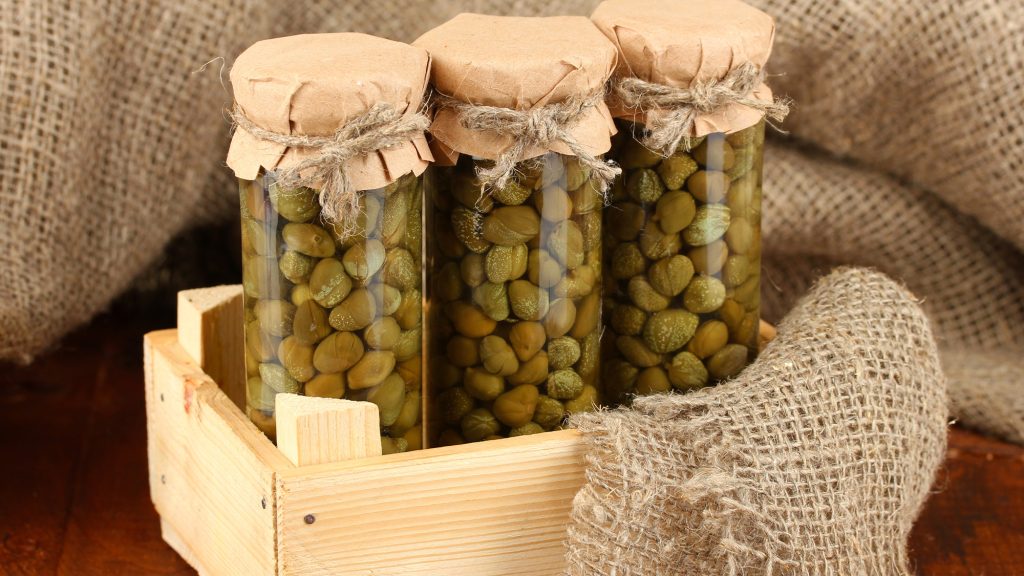This article is part of our Cocktail Chatter series, where we dive into the wild, weird, and wondrous corners of history to share over a cocktail and impress your friends.
If you’ve ever made pasta puttanesca, eggplant caponata, or a proper lox bagel, chances are you’ve encountered capers — which means you’ve also confronted the frustrating, somewhat humbling task of fishing them from their tiny, narrow jar. It’s the epitome of a Champagne problem, but hey, it’s a problem nonetheless.
This begs the question: Why do most caper producers choose tall, skinny vessels over more practical squat ones? Is it some cruel joke? It turns out there are some plausible reasons why these pain-in-the-ass containers persist — more on that below.
What are capers, anyway?
Before we tackle the matter at hand, here’s a brief crash course on what capers actually are. Despite their flavor congruence with olives, the two come from entirely different plant species. Olives are technically stone fruits that grow on trees, while capers grow on thorny bushes. Some believe that capparaceae (the caper family) is indigenous to the tropics, but these days, capers primarily grow in and around the Mediterranean basin. Caper bushes are hardy and quick to adapt to a range of climates, but they flourish in arid and semiarid conditions.
The jarred capers found at the grocery store are actually the unripened buds of the caper bush, or Capparis spinosa. Once they ripen, they bloom into the fruit that is the caper berry. But before that happens, caper harvesters pick the buds by hand and send them to a plant for processing. There, the buds are cured in salt for three to four weeks, then packaged in jars with brine.
Why are caper jars so small?
Explaining what capers are is a hell of a lot easier than breaking down why they’re packed the way they are. Even industry pros scratch their heads over the concept.
“I do understand the frustration of a spoon not fitting, and I don’t have an answer for that,” Russell Zwanka, director of Western Michigan University’s food marketing program, recently told CNN. “I don’t know why you can’t make it just another half an inch bigger.” Still, we can offer a few theories as to why caper manufacturers do this dirty deed.
For one, capers are expensive. Even though they can be harvested every 10-ish days during the warmer months, capers must be picked by hand, and smaller buds tend to fetch higher prices. The smallest ones are categorized as nonpareils, and as capers go up in size, they become floppier in texture and less concentrated in flavor. That makes caper harvesting a relatively labor-intensive process, so manufacturers put them in small jars to make them affordable for the average consumer. The same goes for saffron, pine nuts, and edible gold leaf. Plus, nonpareils are extremely salty, so a few go a long way in the kitchen.
Small containers are fine, but why make them so slim, too? That’s a tougher nut to crack, especially since slender jars are harder to package and run a higher risk of tipping over on production lines. Some attribute the standard caper jar to the rise of the skinny beverage can. What started with Red Bull has permeated the industry to the point where the majority of hard seltzers and canned cocktails come packaged in tall, slim, 12-ounce cans. This all brings us to the possibility that skinny jars are just considered sexier.
It’s also possible that this kind of bottle can prevent capers from spoiling quickly. The tiny opening ensures minimal contact with air and keeps the capers as submerged as possible in their preservative brine. Many Reddit dwellers subscribe to this notion.
In the end, we can’t say for sure why caper producers adhere to these inconvenient jars. However, we can offer a few tips on how to fish those capers without losing your cool.
How to easily remove capers from the jar
These jars are unfit for any standard spoon, and brutishly dumping the capers out poses the risk of losing crucial brine. That’s why we recommend using a cocktail fork, a gelato spoon, tweezers, a boba straw, or even a butter knife to pluck capers from their vessel. None of these options are completely ideal, but they ought to do the trick.
If caper jars ever go the way of the Coors Banquet stubby brown bottle, maybe Goya and Cento make the switch to more stout, Trader Joe’s-ian vessels. Until then, we’ll continue fishing those suckers out with any tiny utensil that’ll get the job done.
*Image retrieved from Africa Studio via stock.adobe.com
The article Why Are Caper Jars So Small? appeared first on VinePair.
